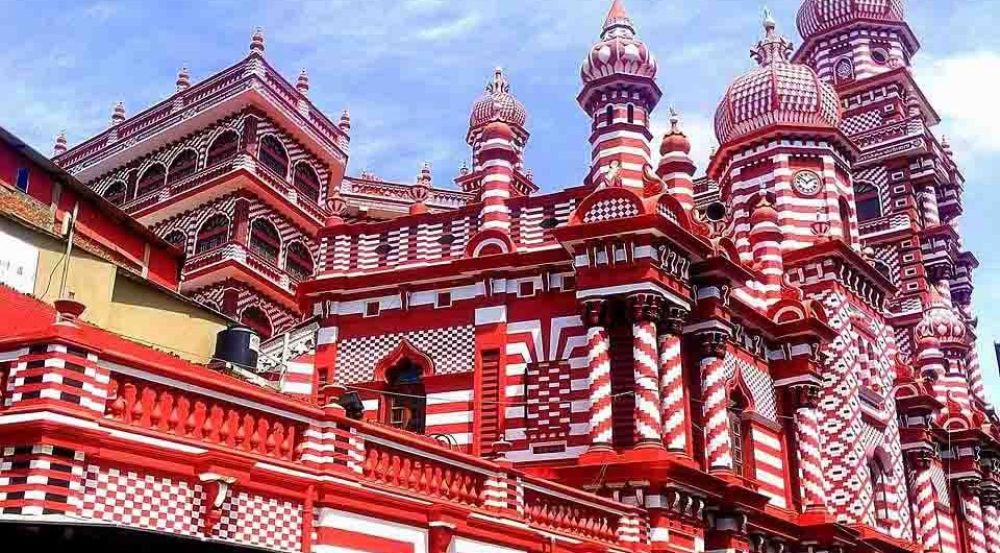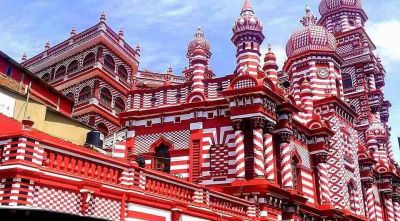

The Jami Ul-Alfar Mosque, commonly known as the Red Mosque, is an architecturally significant building and a popular place of worship in Colombo, Sri Lanka. Embark on a guided historical tour to learn about the mosque's history, dating back to its completion in 1909. During this educational tour, visitors will discover the unique architectural details that combine Indo-Islamic, Neoclassical, and Gothic styles, marked by its striking red and white candy-striped exterior and its pinnacles similar to the Stupa design. Tour guides will share insights into the mosque's significance to the local Muslim community, its role throughout Sri Lanka's history, and the practices observed within. Remember to dress modestly and remove your shoes before entering as a sign of respect.
Jami Ul-Alfar Mosque stands out as a picturesque masterpiece in the bustling Pettah district of Colombo, making it a perfect spot for photographers keen on capturing the essence of Sri Lankan Islamic architecture. A photography session at the mosque allows shutterbugs to snap stunning photos of the exterior facades adorned with intricate brickwork and vibrant colors. Inside, the mosque boasts ornate arches and beautifully decorated ceilings. Enthusiasts can capture the daily life of worshippers and the serene ambiance within. It’s important to seek permission before photographing individuals, and to practice discretion during prayer times to ensure the sanctity of the mosque is maintained.
The Jami Ul-Alfar Mosque offers a unique cultural integration experience for visitors interested in learning about the local Islamic traditions and practices. By participating in this activity, one can immerse themselves in the daily routines, including proper worship techniques and understanding the call to prayer. The experience fosters a greater cultural exchange and mutual respect. Visitors are often welcomed to join in breaking fast during Ramadan evenings, which provides a deeper insight into the communal spirit and hospitality that is central to the Muslim faith. Engaging with members of the local community during this time can be particularly rewarding and insightful.
The Red Mosque serves not only as a place of worship but also as a center for learning and creativity. An educational workshop on Islamic art is often held for those interested in the intricate designs and geometric patterns that are characteristic of Islamic sacred spaces. These workshops may include learning about Arabesque art forms, calligraphy, and tessellation designs, all of which capture the spirituality and cultural expressions within Islamic art. The sessions are great for both adults and children looking to explore their artistic side while respecting the artistic traditions inherent in the mosque’s design.
Observing the evening prayers, known as 'Isha', at Jami Ul-Alfar Mosque can be a profound experience for visitors. The evening prayer is one of five daily prayers observed by Muslims and signifies the end of the day’s rituals. Non-Muslim visitors are generally welcomed to witness this spiritual practice, offering them a unique perspective on Islamic devotion and community life. The rhythmic chanting and group participation demonstrate the mosque’s role as a communal anchor and provides insight into the daily rhythms of worship that define Islamic faith. Visitors should ensure they remain quiet and respectful during the observation, as this is a sacred time for the worshippers.
Jami Ul-Alfar Mosque is at the heart of Pettah’s community life and regularly conducts outreach programs aimed at fostering community wellbeing and assistance. These programs include charitable initiatives, educational seminars, and health clinics. Visitors who are interested in humanitarian efforts can participate or volunteer in these initiatives, giving them a chance to contribute positively to the local society while experiencing the community-centric approach of Islam. Interaction with the local populace through these means often creates lasting impressions and promotes a sense of global citizenship.
Throughout the year, the Jami Ul-Alfar Mosque organizes lectures and discourses led by religious scholars. These sessions cover various topics related to Islamic theology, history, and the contemporary issues facing the Muslim Ummah. Both Muslims and non-Muslims are invited to attend these enriching talks, which provide deep insights into the Islamic faith and its practices. It is an opportunity to engage in meaningful dialogue and to ask questions to expand one's understanding of religious concepts. The lectures foster a deeper appreciation of the mosque's religious and cultural significance within the local community and beyond.
Jami Ul-Alfar Mosque promotes peace and understanding through scheduled interfaith dialogue sessions. Such sessions bring together individuals of different religious backgrounds, allowing them to share and learn from each other’s beliefs, practices, and traditions. These dialogues aim to build bridges between communities, foster mutual respect, and dispel misconceptions about Islam. Visitors who partake in these dialogues come away with a richer understanding of religious pluralism and the common values that unite diverse cultures.
During the holy month of Ramadan, the Jami Ul-Alfar Mosque provides an iftar experience for Muslims and non-Muslims alike. Iftar is the meal eaten by Muslims after sunset to break their fast. Visitors are invited to join in this communal breaking of the fast which typically starts with the eating of dates followed by a prayer and then a meal. This experience allows people of all faiths to come together in a gesture of solidarity and goodwill. It's a moment to share in the communal spirit of generosity and to learn about the practices and the significance of fasting in Islam.
Architecture enthusiasts can indulge in a specialized education tour that delves deep into the Red Mosque's distinctive style, combining elements from indigenous Indo-Islamic and Gothic revival architecture with neoclassical influences. The tour details the design choices that reflect the mosque's historical context, including the use of locally sourced materials and the labor force that contributed to its unique appearance. Visitors will also learn about the symbolism embedded in the architectural elements, the mosque's renovation efforts over the years, and its adaptation to the modern urban environment while still retaining its original character.
